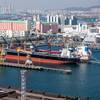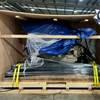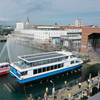Great Lakes Execs, IMO Talk Invasive Species
The delegation discussed ballast water and aquatic invasive species issues, which is presenting the world’s marine community with a growing environmental challenge. The meeting underscored the importance of the partnership between the government and industry in the Great Lakes St. Lawrence Seaway System to seek a viable solution to effectively manage and eventually eliminate aquatic invasive species.
Sainlos provided the group a global perspective on the state of ballast water activities from both a political and technological standpoint, discussing the ballast water convention approved in February 2004. The Convention requires that ballast water treatment technologies meet specific technical discharge standards. The Convention must be adopted by 30 countries before it can be ratified.
Sainlos supported the Seaway’s environmental efforts and pledged to work closely with the delegation to promote and advance new treatment technologies currently under development. The IMO is required to make a determination of whether appropriate technologies are available to achieve the standard by 2006.
“There are federal and state proposals in the U.S. to impose new ballast water regulations, as well as a recent court ruling that could have a far-reaching impact on marine transportation,” said Administrator Jacquez. “The Seaway System is working with the marine industry to support and promote new R&D technologies that are designed to effectively manage ballast water safely, efficiently, and affordably.”
Corfe noted that in the past few months, Transport Canada has issued proposed regulations that would require mandatory ballast water management and the implementation of the IMO discharge standard. “We are exploring, along with Transport Canada and our other Ministries, how to provide some form of incentives for ‘green’ vessels that meet specific environmental standards to offset Seaway costs.”
Corfe shared with IMO officials the latest efforts of Fednav, the largest international carrier operating in the Great Lakes St. Lawrence Seaway System. The Fednav vessel, the Federal Welland, has been retrofitted with new technology using filtration and nitrogen supersaturation to kill unwanted aquatic species and is scheduled to test the technology in late November. The technology is Norwegian-developed and patented as the OceanSaver System.
The Seaway Trade Mission delegates are meeting with high level representatives of European shipping companies, government officials, international maritime organizations, bulk cargo exporters, and the cruise ship industry.
This trade mission, the 28th in a series over two decades, is designed to facilitate face-to-face contact with maritime industry leaders and decision-makers to promote greater use of the Great Lakes St. Lawrence Seaway System. In addition to the Administrator of the U.S. Seaway Corporation and the President of the Canadian Seaway Corporation, the 22-member delegation is comprised of the largest port and terminal operators from the US and Canada, shipowners and operators, shipping agents, cruise industry representatives, and maritime trade specialists.













